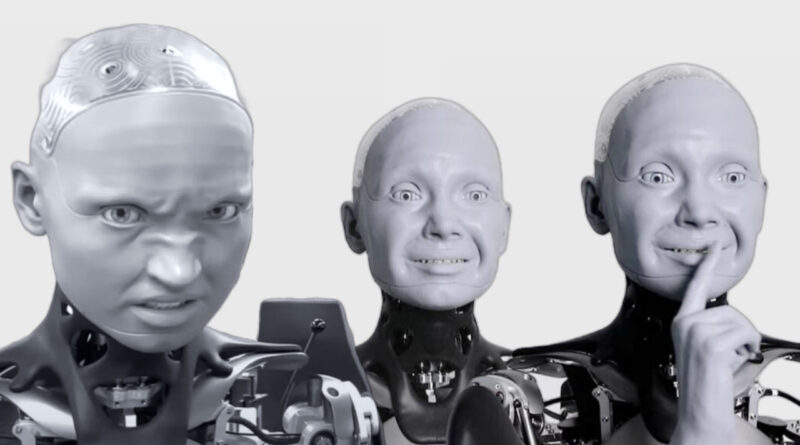Ameca: Bridging the Gap Between Humans and Robots with AI
Introduction to Ameca
Advancements in robotics and artificial intelligence (AI) have paved the way for the creation of humanoid robots! This tech advancement blurs the boundaries between humans and machines. One such remarkable example is “Ameca“. An anthropomorphic humanoid robot designed to replicate human appearance and behavior. Through its integration of cutting-edge AI technologies, Ameca aims to bridge the gap between humans and robots, revolutionizing the way we interact with machines.
Popular Recommendation: How To Make NFT For Metaverse?
The Human Touch
Ameca’s human-like body structure and appearance contribute to its ability to establish a more intuitive connection with humans. By closely resembling us in form, it evokes a sense of familiarity and trust. Which enables more natural and meaningful interactions. In addition to this, with facial expressions and gestures, Ameca can convey emotions and intentions, fostering empathy and facilitating seamless communication.
Perception and Understanding
At the core of Ameca’s AI capabilities lies its sophisticated perception and understanding of the world. Equipped with a variety of sensors, such as cameras, microphones, and touch sensors, Ameca can interpret and make sense of its environment. It can recognize faces, objects, and speech, enabling it to respond appropriately and adapt to different situations.
Learning and Adaptation
Ameca’s AI algorithms empower it with the ability to learn and adapt over time. Through continuous exposure to data and experiences, it can recognize patterns, understand human preferences, and make informed decisions. This learning capability allows Ameca to refine its performance, improving its ability to assist humans in various tasks.
Applications and Impact
The potential applications for humanoid robots like Ameca are vast and impactful. In healthcare settings, Ameca can assist medical professionals in tasks such as patient monitoring, data analysis, and even performing complex surgeries with precision. Its human-like presence can also offer emotional support to patients, enhancing the overall care experience.
Additionally, in industrial environments, Ameca can tackle physically demanding and hazardous tasks, ensuring the safety of human workers. With its ability to adapt and learn, it can optimize workflows, improve efficiency, and contribute to increased productivity.
Beyond functional roles, Ameca has the potential to provide companionship to individuals. Those who are in need of social interaction, such as the elderly or people with disabilities. Its presence can alleviate feelings of loneliness and offer emotional support, promoting overall well-being.
Ethical Considerations
As humanoid robots like Ameca become more prevalent in society, it is crucial to address the ethical considerations associated with their use. Here are some key aspects to consider:
Privacy and Data Security
Humanoid robots like Ameca interact closely with humans and collect vast amounts of data during their operation. Ensuring the privacy and security of this data is of paramount importance. Organizations and developers must implement robust data protection measures, including encryption, secure storage, and strict access controls. In order to safeguard sensitive information and prevent unauthorized use or disclosure.
Transparency and Accountability
As AI algorithms power Ameca’s learning and decision-making processes, it is vital to ensure transparency and accountability in its actions. Humans should have the ability to understand how Ameca reaches its decisions, especially in critical tasks like medical diagnosis or autonomous decision-making. Clear guidelines and regulations should be in place to prevent biased or unethical outcomes and to enable recourse if any harm or unfairness arises.
Job Displacement and Economic Impact
The introduction of humanoid robots in various industries may raise concerns about job displacement and the economic impact on human workers. While robots like Ameca can enhance productivity and efficiency! Organizations must consider retraining programs and opportunities for workers affected by automation. Moreover, governments, businesses, and educational institutions should collaborate to provide reskilling and upskilling initiatives to ensure a smooth transition for the workforce.
Human-Robot Interaction and Social Implications
Humanoid robots like Ameca have the potential to blur the boundaries between humans and machines. It is crucial to establish guidelines and norms for human-robot interactions, ensuring that they are respectful, considerate, and aligned with societal values. Furthermore, addressing questions about robot rights, autonomy, and the impact on human relationships is essential to foster a harmonious coexistence between humans and robots.
Long-Term Effects on Human Development
The integration of humanoid robots in various aspects of human life, such as healthcare and companionship, raises questions about the long-term effects on human development, particularly in vulnerable populations. Researchers, policymakers, and ethicists need to closely monitor and study the impact of human-robot interactions on social, emotional, and cognitive aspects. Keeping a focus on ensuring that humans maintain a healthy balance between human-human and human-robot relationships.
Bias and Fairness
Humanoid robots like Ameca rely on AI algorithms that can be susceptible to bias. Care must be taken during the design and training phases to minimize biased outcomes across different demographics. Regular audits and assessments should be conducted to identify and rectify any biases that may emerge in Ameca’s behavior or decision-making processes.
Similarly, by proactively addressing these ethical considerations, we can shape the development and deployment of humanoid robots like Ameca in a responsible and beneficial manner. Collaboration between policymakers, researchers, and society as a whole is crucial to ensure the ethical and responsible use of AI technologies. Fostering trust, and maximizing the benefits for humanity.
Ameca’s Conclusion
Ameca, the humanoid robot, represents a significant advancement in the realm of AI and robotics. With its human-like appearance, perception, and learning capabilities, it seeks to bridge the gap between humans and machines. Also revolutionizing how we interact with robots. The integration of AI into humanoid robots like Ameca opens up a world of possibilities, ranging from healthcare and industry to companionship and emotional support. By embracing these technologies responsibly, we can unlock their full potential and shape a future where humans and robots coexist harmoniously.
Must Read: AI-assisted Medical Diagnosis Transforming HealthCare Industry

